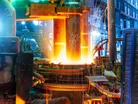China's Steel Industry 'Facing GHG Challenge'

In the first of a two-part look at China's steel industry, we detail the analysis of Jane Nakano -- Senior Fellow at the Energy Security and Climate Change Program at the Center for Strategic and International Studies (CSIS) -- who details the Chinese State's policies that are designed to steer the industry towards sustainability.
China's steel industry, the world's largest by production capacity, is grappling with significant challenges that have far-reaching implications for the global construction sector, says a leading sustainability analyst.
Jane Nakano, Senior Fellow at the Energy Security and Climate Change Program at the Center for Strategic and International Studies (CSIS), shares insights into the complex issues facing the industry and the potential solutions being implemented.
She points out that the steel industry in China – which plays a crucial role in the country's economic development – is facing a dual challenge of overcapacity and high greenhouse gas (GHG) emissions.
Nakano explains that overcapacity is “exacerbated by weakened domestic demand”, as well as by intensifying price competition in the global market and “trade friction with other global steel exporters".
This situation, she adds, is further complicated by China's commitments to achieving peak carbon emissions by 2030 and carbon neutrality by 2060.
She identifies two recent domestic policies as potential solutions to address these challenges: the Special Action Plan for Energy Conservation and Carbon Reduction in the Steel Industry and the nation’s China-wide Trade-in Program.
China steel industry 'in feedback loop'
Nakano suggests these policies are "creating a feedback loop by connecting the upstream and downstream in the steel sector", and that they form a “nascent circular economy framework for the steel industry” – one in which “strong synergy exists between the measures for rapid adoption of low-carbon production methods and those for expanding green sectors, such as electric vehicles and renewable energy, as an outlet for the excess steel supply".
The Special Action Plan was launched by the Chinese government in May 2024, with the objective to reduce carbon dioxide emissions by approximately 53 million tons between 2024 and 2025.
It seeks to achieve this in two ways: by strengthening capacity regulation and output management, and transitioning to Electric Arc Furnaces (EAFs), to replace blast furnace-converter steelmaking.
EAF technology relies primarily on scrap steel as the main feedstock, reducing emissions by up to 70% per ton of steel produced compared to blast furnace technology.
Nakano notes that "the goal is to increase the share of EAF-produced steel from 10% today to 15% by 2025, premised on securing sufficient scrap steel as their key feedstock."
State programme to stimulate demand and recycling
Launched in March, the National Trade-in Programme aims to stimulate domestic demand and support economic recovery. The programme consists of three areas of measures:
- Accelerating equipment upgrades in key industries
- Promoting the trade-ins of consumer goods
- Improving the recycling of old traded-in equipment and consumer goods
The Trade-in Program, says Nakano, plays a dual role in the steel industry.
“On one hand it aims to incentivise the recycling of scrap steel through large-scale trade-ins of old equipment and consumer goods,” she says. “And on the other hand it stimulates demand for new and more sustainable goods, providing a market for excess steel produced by the industry.”
Nakano says Chinese experts estimate that the initiative could generate as much as 1 trillion yuan (approximately $141 billion) in market demand, while encouraging sustainable transformation across various sectors.
Addressing steel overcapacity and decarbonisation
Nakano observes that when considered together, the Chinese state’s two sets of measures “form a complementary system that ties the steel industry's upstream and downstream processes”.
She also says that “while no official document or statement appears to discuss whether or how these two were intended to interact, they seem to have created a circular economy framework that addresses both overcapacity and decarbonisation".
Nakano adds: “In the upstream, the Trade-in Program seeks to ensure the availability of scrap steel from recycled and dismantled vehicles and other consumer goods.
“This helps to boost scrap supplies, which are essential for the transition to EAF steelmaking. As scrap supply increases, the steel industry can expand EAF capacity, allowing it to successfully phase out carbon-intensive blast furnaces.”
She continues: “In the downstream, the Trade-in Program can stimulate demand for steel products through large-scale equipment upgrades and consumer goods trade-ins.”
Nakano notes, too, that by creating new demand for steel – particularly in green sectors such as electric vehicles – the programme “can create an outlet for the surplus".
“This demand stimulation, working in tandem with stricter capacity regulation and output management driven by the Special Action Plan,” she says, “creates opportunities for the production of more resource-efficient and lower-carbon steel.
_______________
Check out the latest issue of Construction Digital and sign up to our global conference series, Manufacturing LIVE 2024. Construction Digital is a BizClik brand.
- Deloitte: Green Steel is Scope 3 Answer for ConstructionSustainability & Green Building
- China's Steel Industry Policies Targeting CircularitySustainability & Green Building
- Heat Pumps ‘Key to Built Environment Decarbonisation Goals’Sustainability & Green Building
- Dubai Sustainable City claims first net zero carbon buildingConstruction Projects




